A thorough how-to guide to Chinese hot pot covering all aspects of preparing this iconic meal at home. It will help you to throw a stress-free hot pot party.
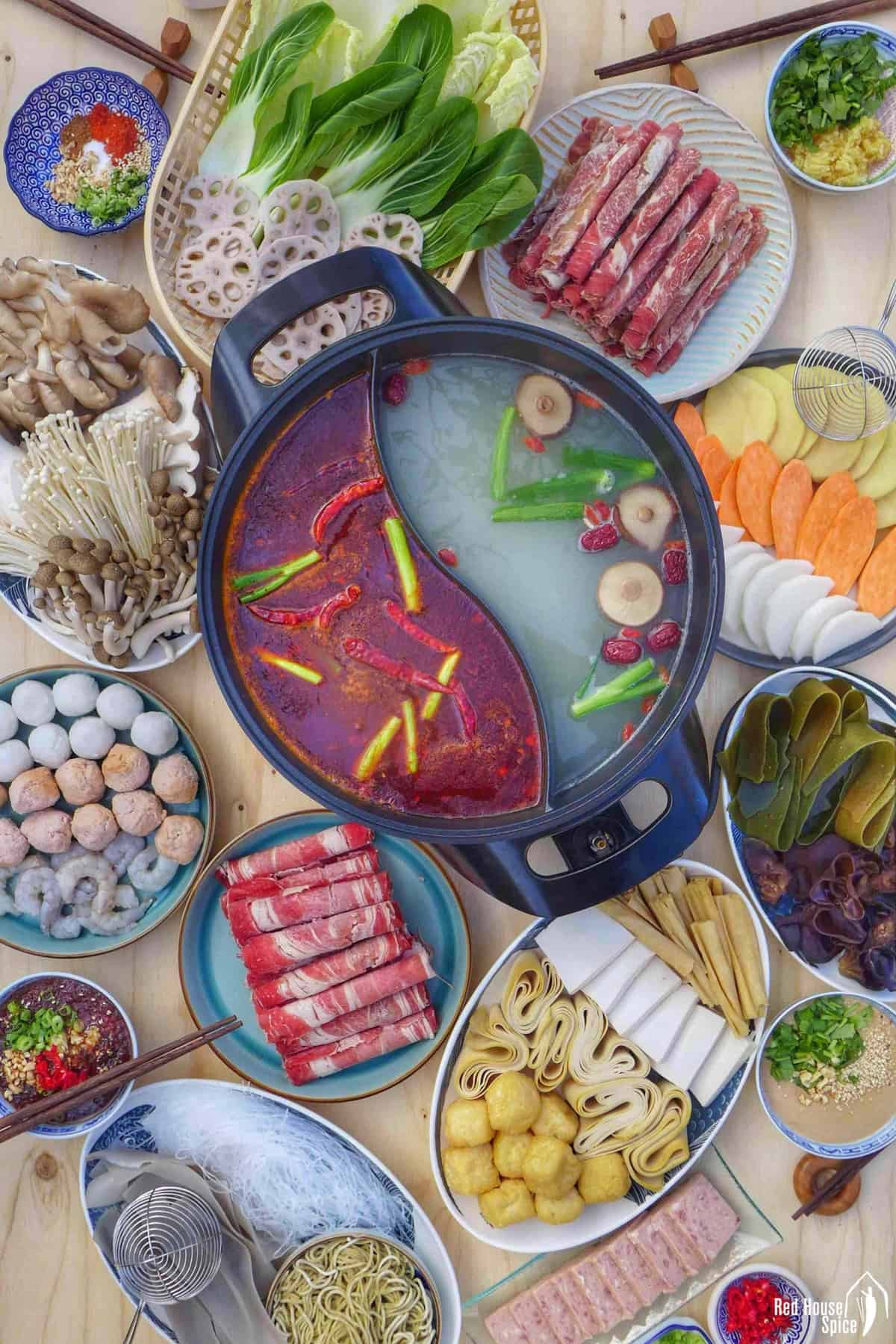
What is hot pot
The Chinese name for hot pot, Huo Guo/火锅, literally means “fire pot”. It’s a communal meal that involves a pot filled with broth constantly simmered by a heat source underneath, a variety of food items around the pot that are cooked in the broth by every diner and then dipped in sauces for extra flavour.
Unlike other Chinese dishes which draw a clear line between the cook and the diners, hot pot is an eat-as-you-cook type of meal where everyone participates in cooking while enjoying the food at the same time.
It’s an ideal party meal
Popular in almost all regions, hot pot restaurants can be found everywhere in China and most of them are reasonably priced. However, Chinese families still enjoy having hot pot in the comfort of their own homes.
It makes a wonderfully fun meal for parties and festive gatherings. Every component, namely the broth, dipping items and dipping sauces, can be prepared in advance. This frees the host on the day.
This hot pot at home guide will cover the following sections:
- Equipment needed
- How to prepare the broth
- Food items to cook
- Dipping sauce choices
- Meal set-up procedure
- Extra pro tips
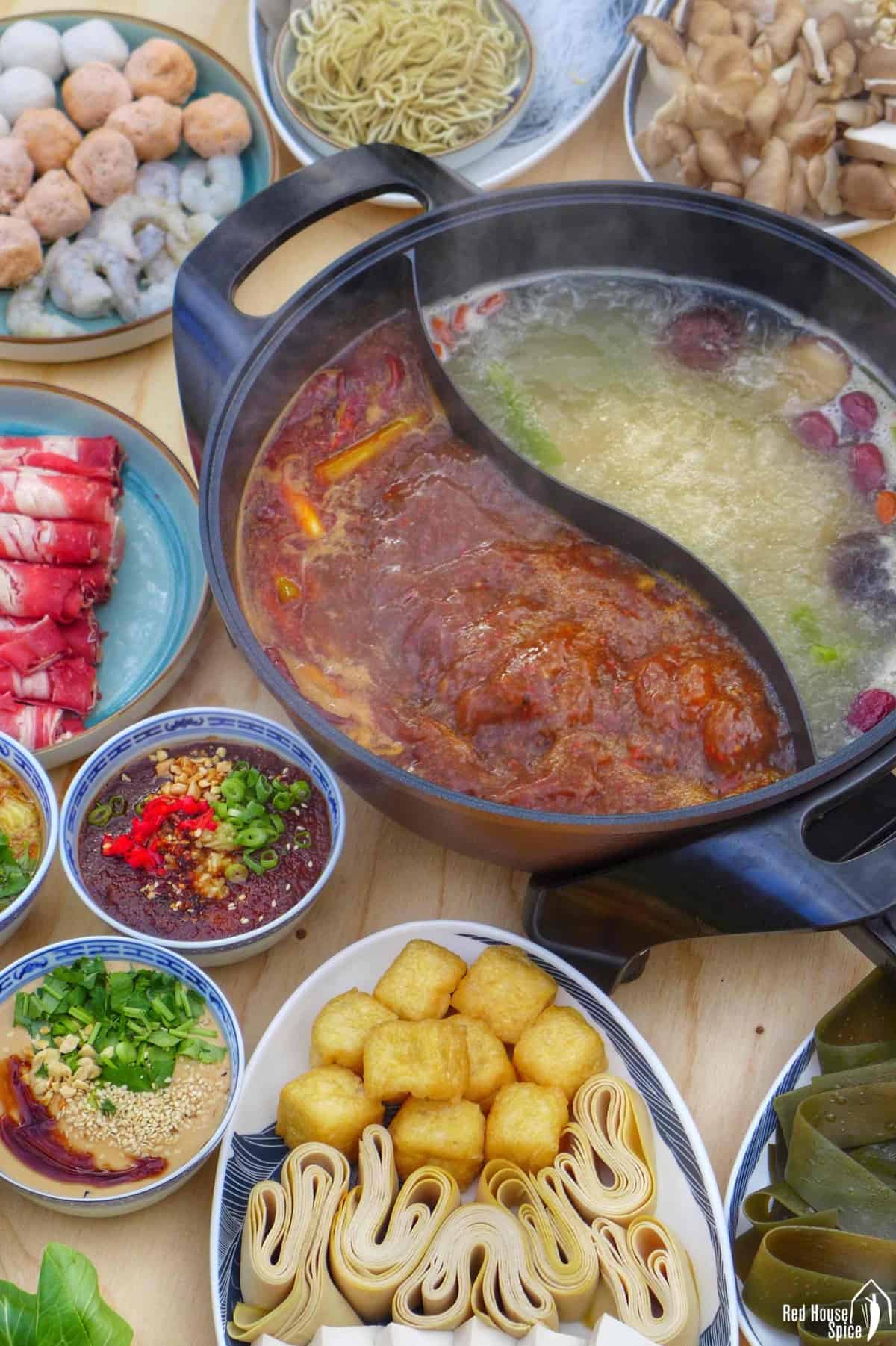
Equipment
Before talking about the ingredients, let me first explain what equipment, cookware and tableware you’d need for a hot pot meal. You can find them in most large Chinese/Asian grocery stores.
- A tabletop heat source. It can be a portable gas, electric or induction burner. If it’s a gas one, make sure it’s suitable for indoor use when you plan to have the meal inside.
- A pot or wok that sits stably over the heat source. It should be shallow enough that diners can easily scoop out the cooked ingredients. If you’d like to go the extra mile, buy a divided pot (Yuan Yang Guo, 鸳鸯锅) which has a wall in the middle to separate two different types of broth (usually spicy and mild). It’s also known as Yin-Yang Hot Pot (as it resembles the Yin-Yang symbol).
- Plates for holding various food items.
- Bowls for dipping sauces (Usually one bowl per diner). And some small side plates in case you don’t want to dip everything in the sauce.
- Chopsticks. Use wooden or bamboo ones. Plastic chopsticks might not be suitable for high heat (the hot pot broth is above boiling point). Whereas metal ones would get too hot to hold. Extra-long hot pot chopsticks are available in Chinese shops, but they aren’t compulsory.
- Slotted spoons (optional). They’re handy for fishing out slippery items. But you can definitely survive without it. A long-handled spoon or a pair of tongs would work too.
PS: The divided pot I use (see image) has its own electric heating element underneath so I don’t need a separate burner (You can find it when searching “electric hot pot”)
How to prepare the broth
Hot pot broth (Guo Di/锅底) is the liquid in which you cook various food items. Hot pot from different regions calls for different broth. They range from the simplest version with just water and a few aromatics (e.g. the Beijing style) to the complicated one that involves a long list of ingredients and lengthy preparation (e.g. the Sichuan style).
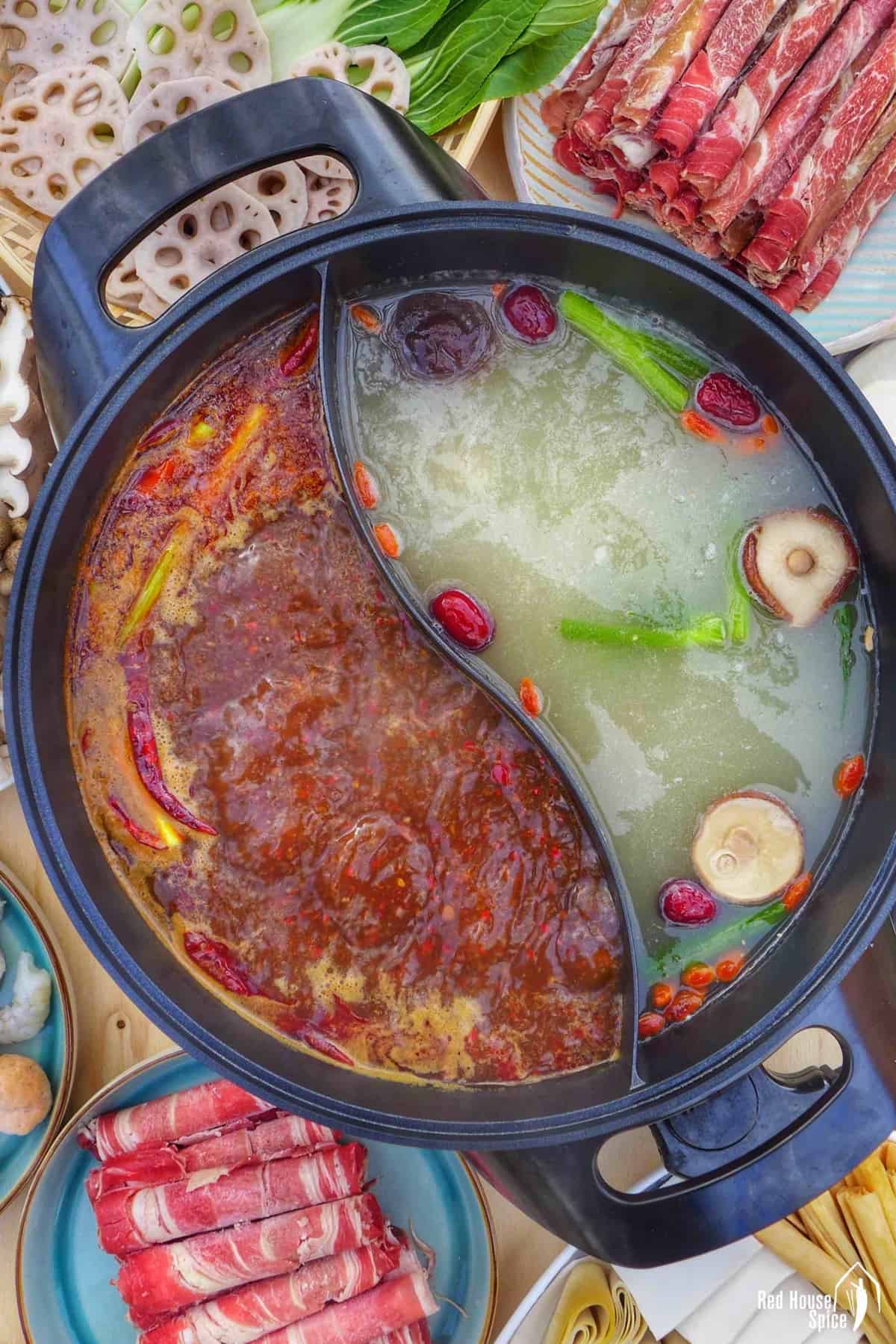
I’d like to introduce two types of hot pot broth that are the most popular ones in restaurants nowadays: mild broth and spicy broth.
The mild broth
Also known as clear broth (Qing Tang Guo Di/清汤锅底), it’s a simple combination of stock, scallions, ginger and a few optional dried ingredients, such as shiitake mushroom, Chinese dates, Goji berries, etc. The stock can be made of meat (chicken, pork or beef), mushrooms or tomatoes.
The spicy broth
This is the classic Sichuan style also known as red oil broth (Hong You Guo Di/红油锅底). Usually, you mix a premade, concentrated soup base, either shop-bought or homemade, with water or stock. The soup base consists of chilies, Sichuan peppercorns and other spices, fermented ingredients like Sichuan chilli bean paste, aromatics, and beef tallow (or regular cooking oil for vegetarians)
Buy the soup base or make your own
In Chinese stores, you can find packages of soup base for both the mild and the spicy versions. With them, all you need to do is just dilute the package content with water. Your hot pot broth is ready within a few minutes. Reputable brands include Hai Di Lao (海底捞), Little Sheep (小肥羊), Lee Kum Kee (李锦记), Qiao Tou (桥头), Da Hong Pao (大红袍), De Zhuang (德庄), etc.
That said, I’d encourage those who are keen to make food from scratch to try my recipes for Homemade Hot Pot Broth (Mild & Spicy). It tastes wonderful and is likely more healthy (no additives, preservatives, etc.) You can make it in big batches and freeze it for later.
What to cook in hot pot
There are so many things that can go into a hot pot, if not everything! Here I list items that are common and typical for Chinese hot pot meals and can be found in Chinese/Asian shops outside China. But this is by no means a complete list.
Please feel free to improvise, mix and match whatever you wish. Make it heavy on proteins, or exclusively vegetarian. It’s entirely up to you.
Before the hot pot party starts you can prepare the ingredients in advance (up to a day if using the fridge to store). By preparation, I simply mean washing them if necessary and cutting (or tearing) them into bite-sized pieces for easy cooking.
Meat
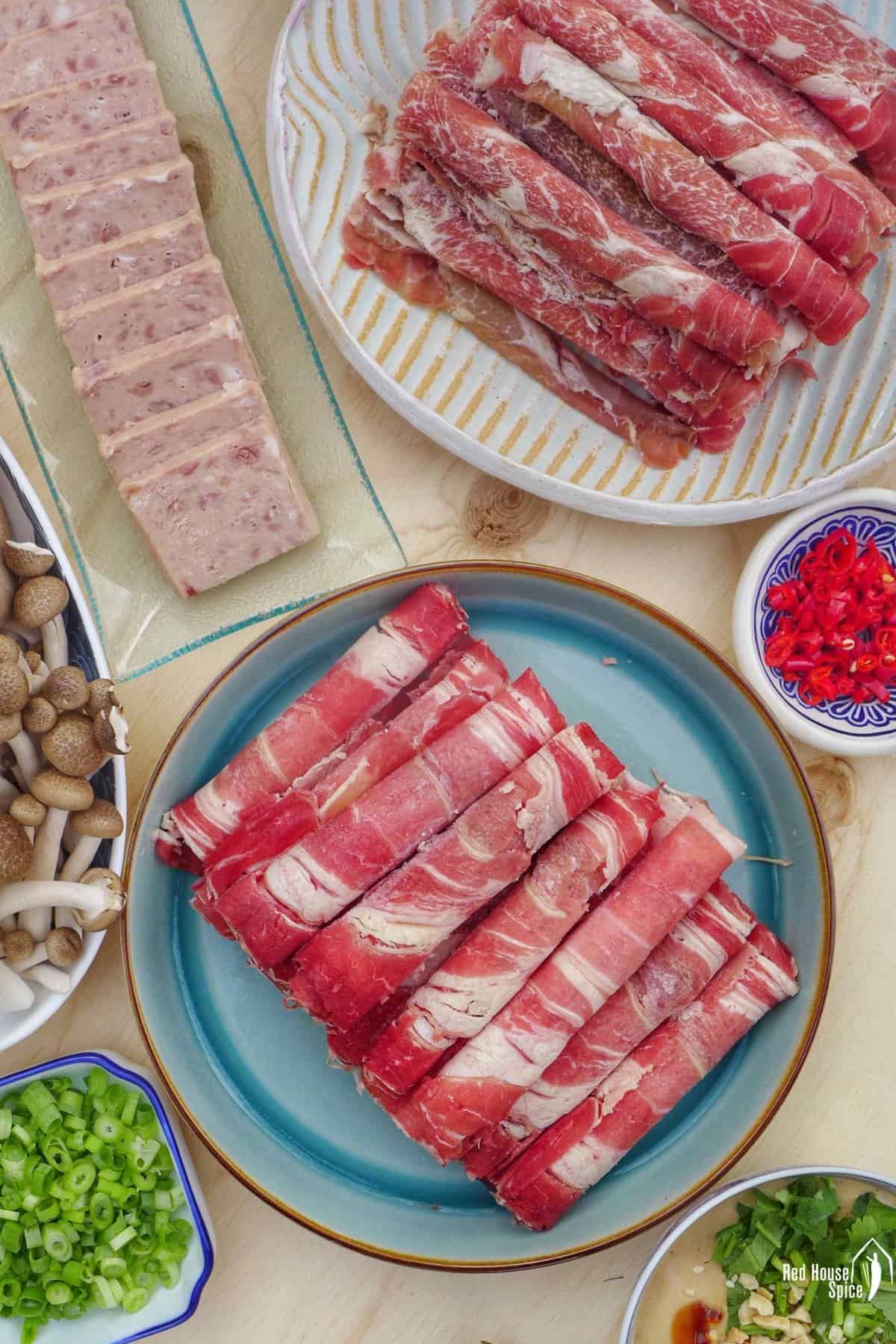
- Beef, lamb or pork, choose well-marbled cuts if possible. Cut it into thin slices against the grain. To make slicing easier, put the meat into the freezer until half frozen. You can find sliced meat for hot pot in the frozen food section of Chinese stores
- Precooked meatballs, defrosted if frozen
- Canned meat (Spam), aka Wu Can Rou/午餐肉 in Chinese, cut into slices
Fish and seafood
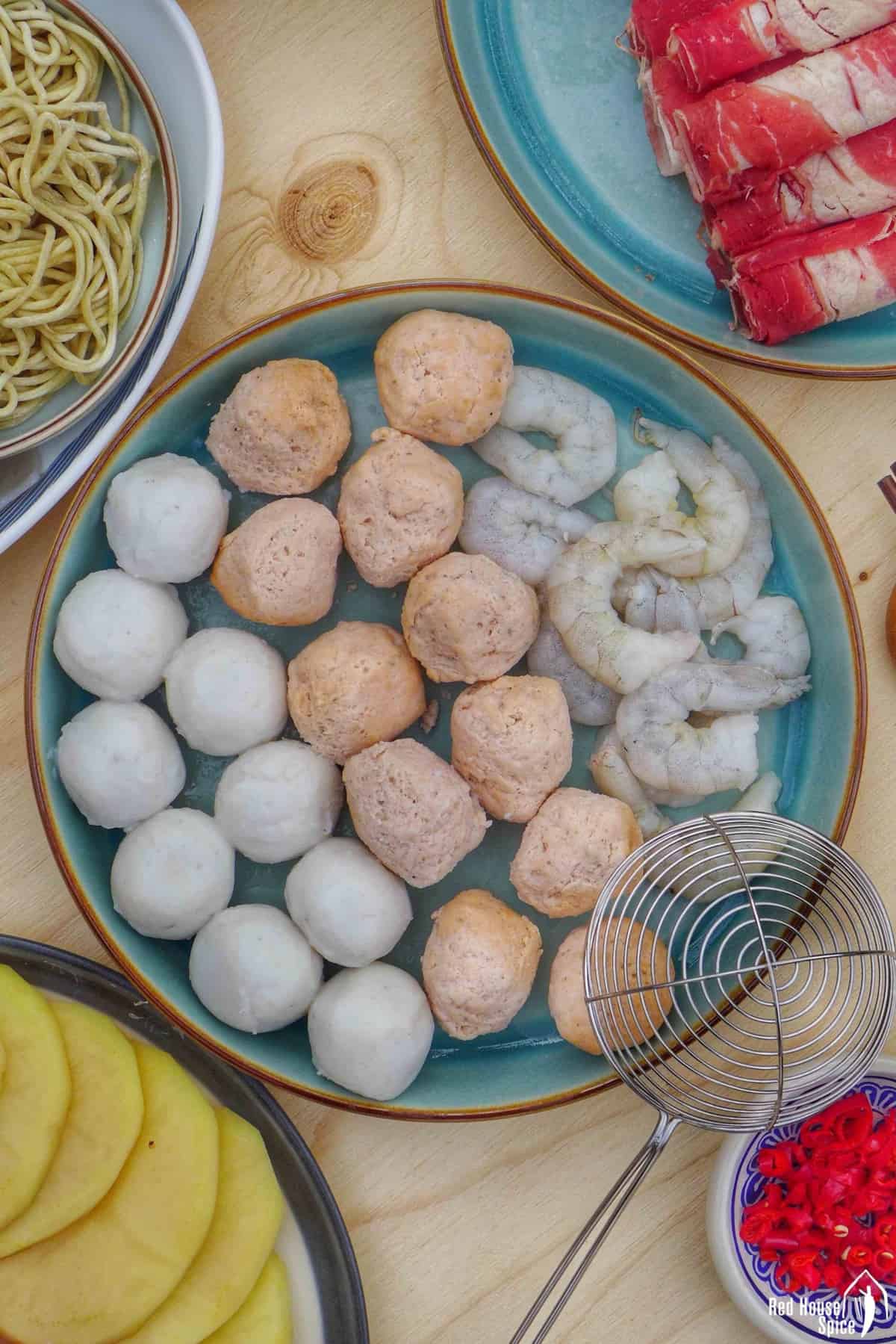
- Fish, choose a boneless fillet and thinly slice. Such as halibut, catfish, cod, sea bass, pangasius, etc.
- Shrimp, with or without the skin/head
- Squid, sliced
- Fish balls. Ready-made ones are available in Chinese stores
- Fresh fish or shrimp paste, shape it into balls during the meal
- Other seafood, such as crabs, clams, mussels, etc.
Soybean based ingredients

- Tofu (silken, soft or firm), sliced
- Frozen tofu, sliced
- Tofu puffs (deep-fried tofu)
- Pressed tofu sheets (Dou Fu Pi/豆腐皮), cut into wide strips
- Dried tofu skin (Fu Zhu/腐竹), rehydrated beforehand
Mushrooms
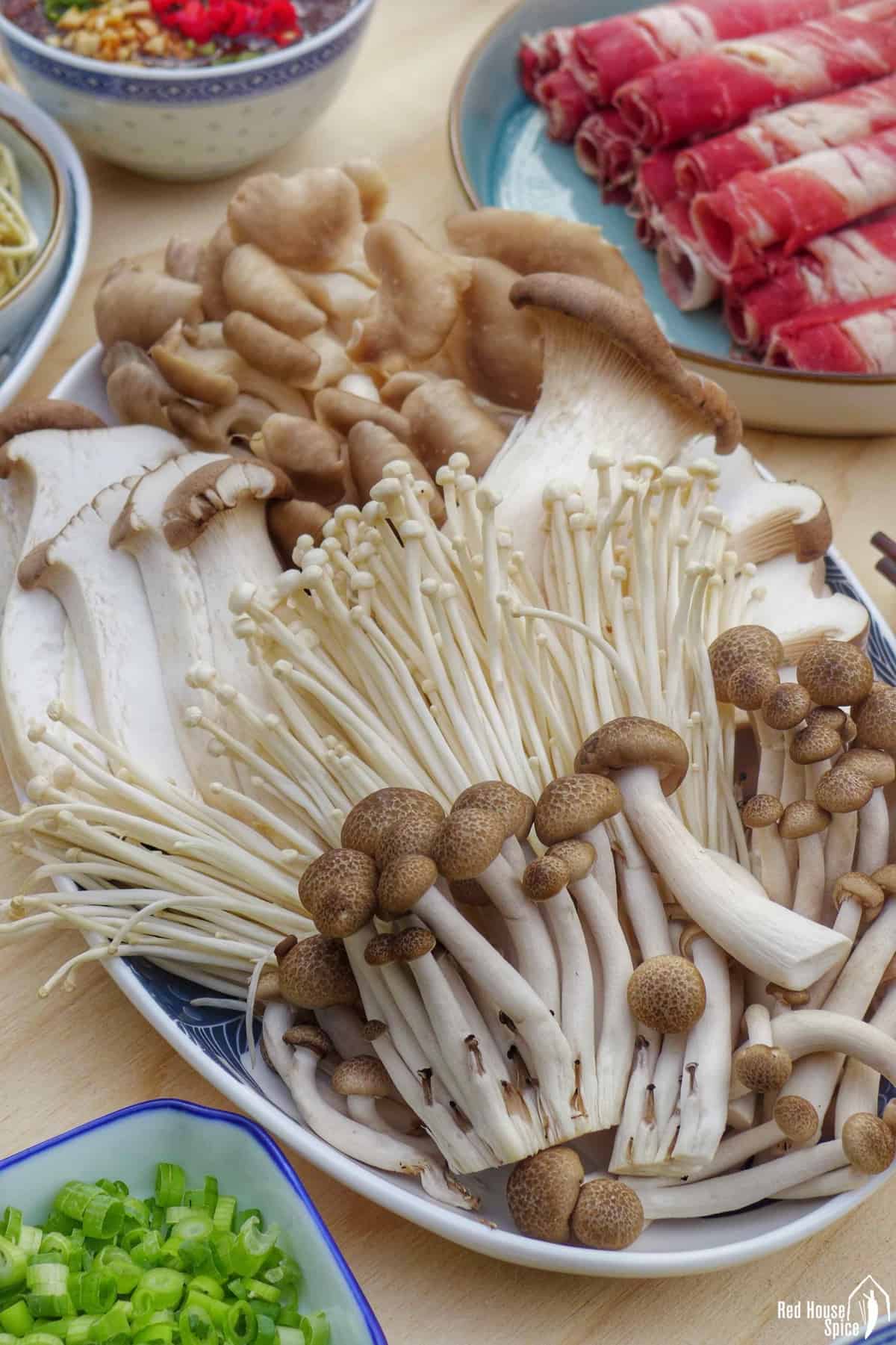
- Oyster mushroom, separated into small sections
- King oyster mushroom, sliced lengthways
- Enoki mushroom, ends removed and torn into small bundles
- Shiitake mushroom, fresh or dried (rehydrated beforehand)
- Shimeji mushroom, ends removed
Leafy greens
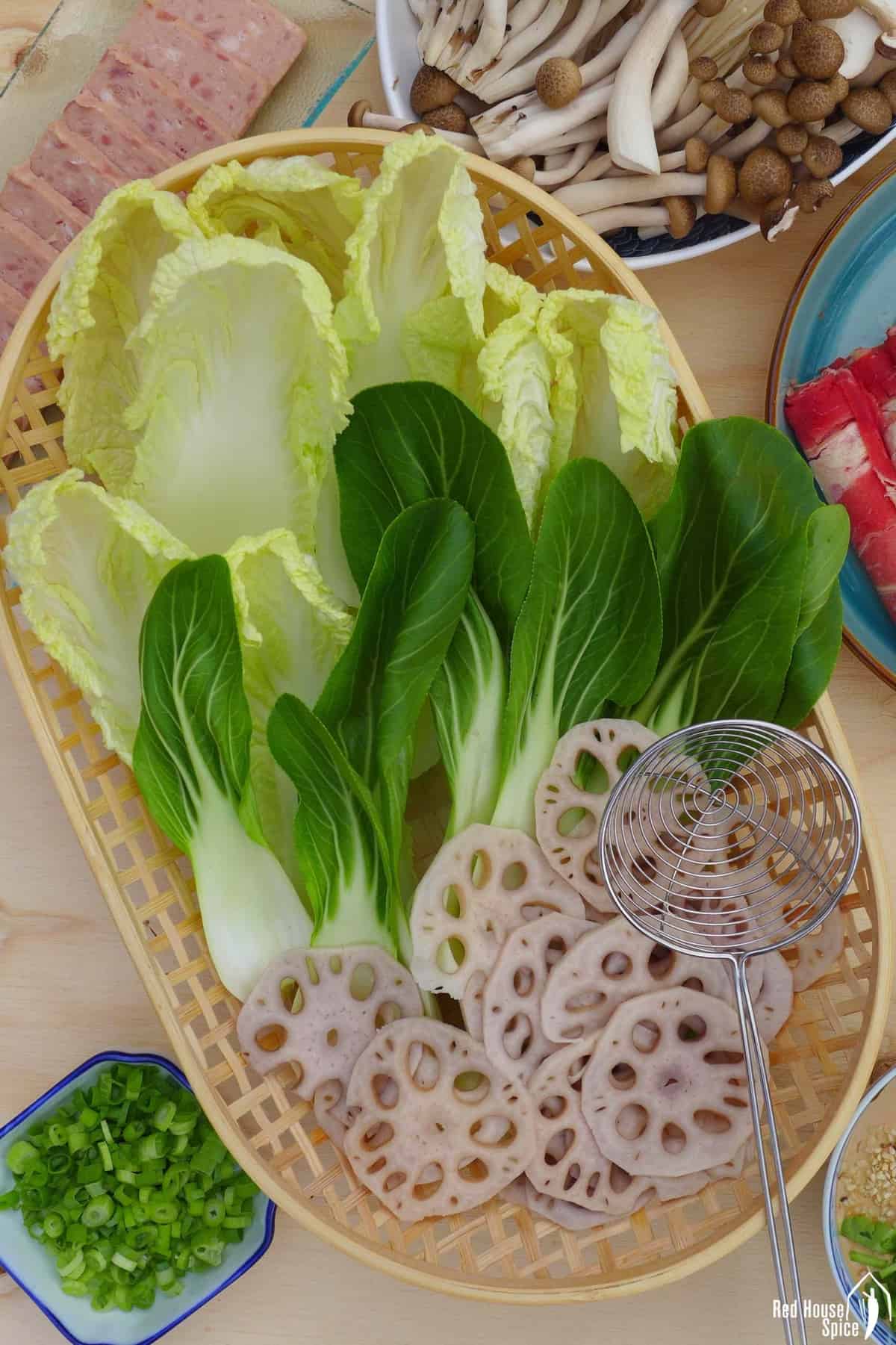
- Napa cabbage
- Bok choy
- Choy sum
- Gai Lan
- Crown daisy (Tong Hao)
- Water spinach
- Watercress
Root vegetables
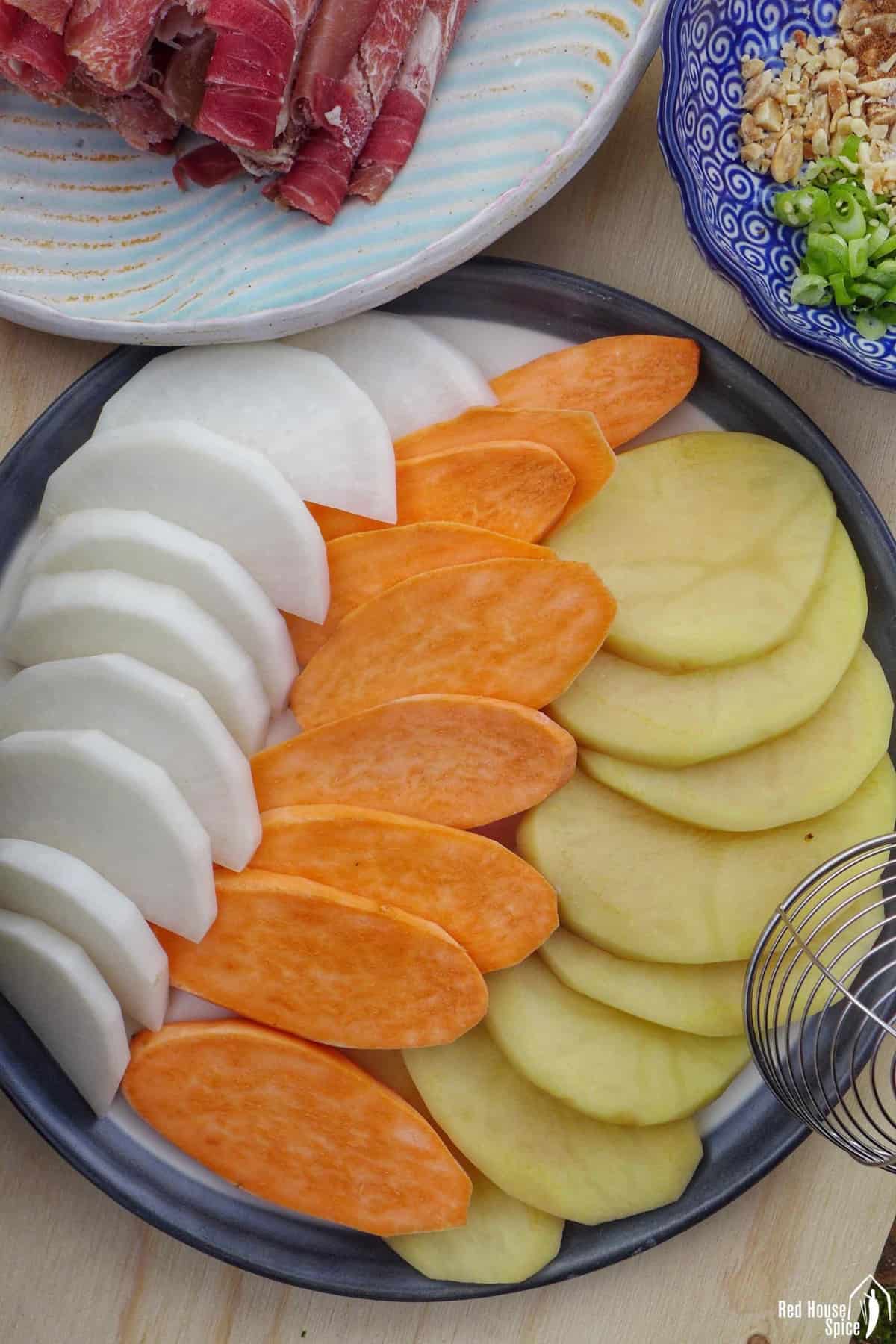
- Potato, peeled and sliced
- Sweet potato, peeled and sliced
- Daikon (white radish), sliced
- Lotus roots, sliced
Dried ingredients
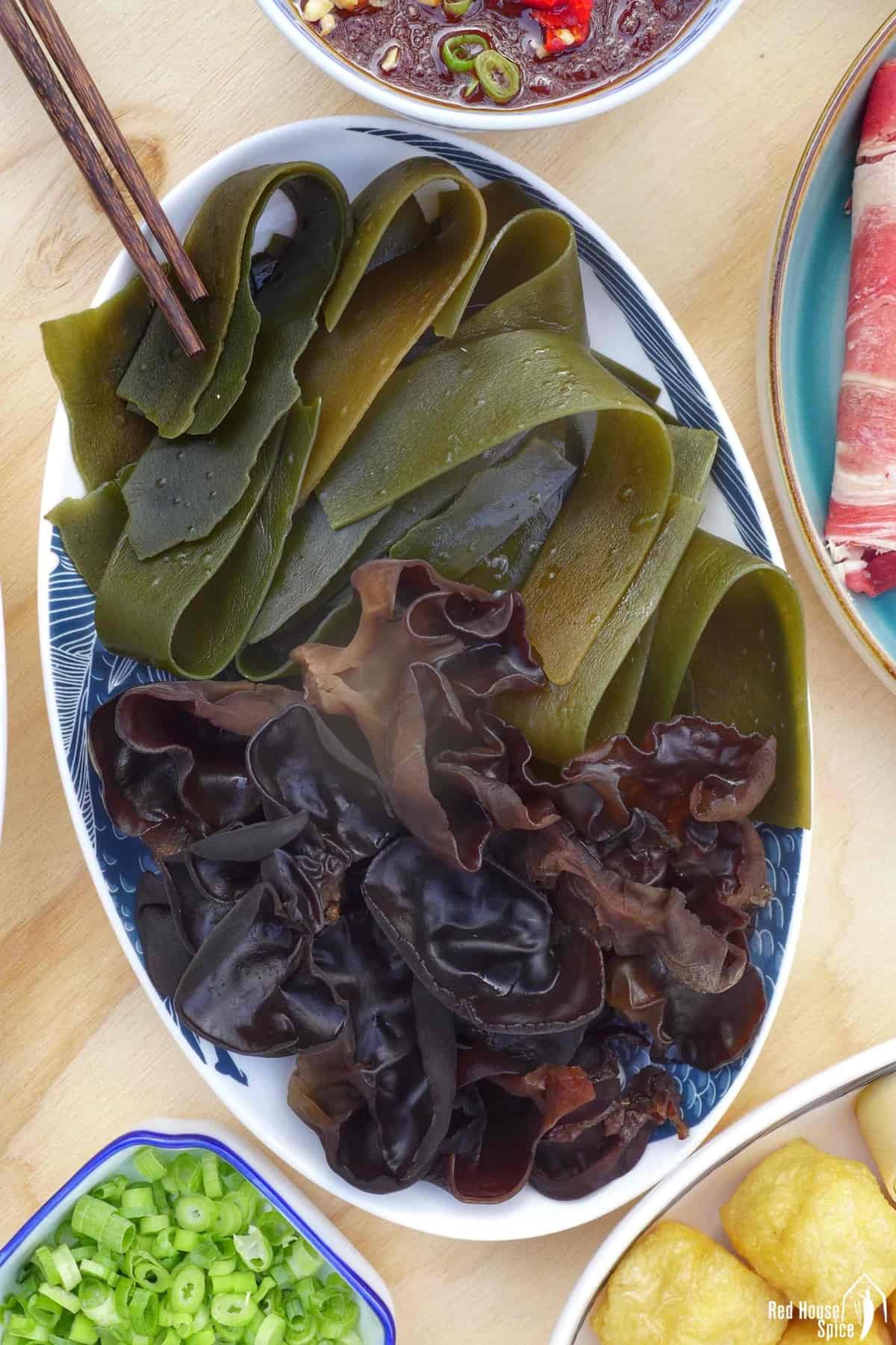
- Kelp (A type of seaweed). rehydrated and cut into strips.
- Wood ear (A type of fungus). rehydrated beforehand
Noodles and dumplings

- Fresh wheat noodles, e.g. alkaline noodles
- Instant ramen
- Fresh rice noodles and sliced rice cakes
- Mung bean vermicelli, presoaked
- Sweet potato glass noodles, presoaked
- Hand-pulled noodles. Have the dough made, rested and cut into strips. Pull one noodle at a time and drop it into the broth straightaway.
- Dumplings or wontons, either homemade or shop-bought. Make sure to cook only a few at a time.
Dipping sauce ideas
After cooking food items in the broth, it’s common to dip them into a sauce for extra flavour (although it’s not compulsory). The formulas are numerous and often dramatically different between regions. That’s why some hot pot restaurants have dipping sauce stations where you can mix and match different ingredients to create your own.
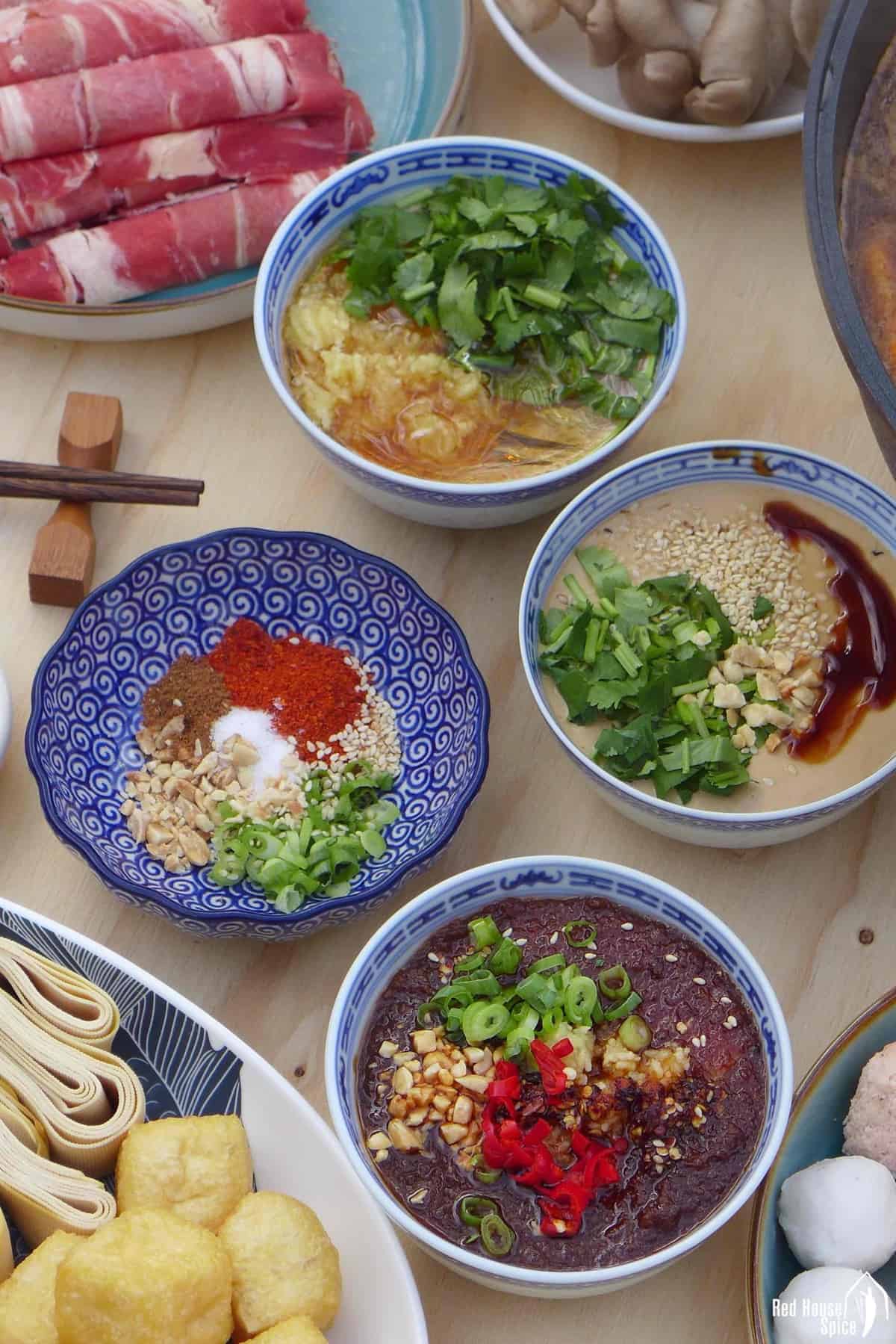
Here is a list of condiments, aromatics, fresh herbs and nuts that can go into a hot pot dipping sauce:
- Sauces: light soy sauce, black rice vinegar, oyster sauce, shacha sauce (Chinese barbecue sauce)
- Pastes: sesame paste, peanut butter, fermented bean curd
- Oil: sesame oil, chilli oil
- Spices: chili powder, ground Sichuan pepper
- Aromatics: minced garlic, coriander, scallions, fresh chilli
- Nuts: toasted sesame seeds, toasted peanuts
Hot pot meal set-up procedure
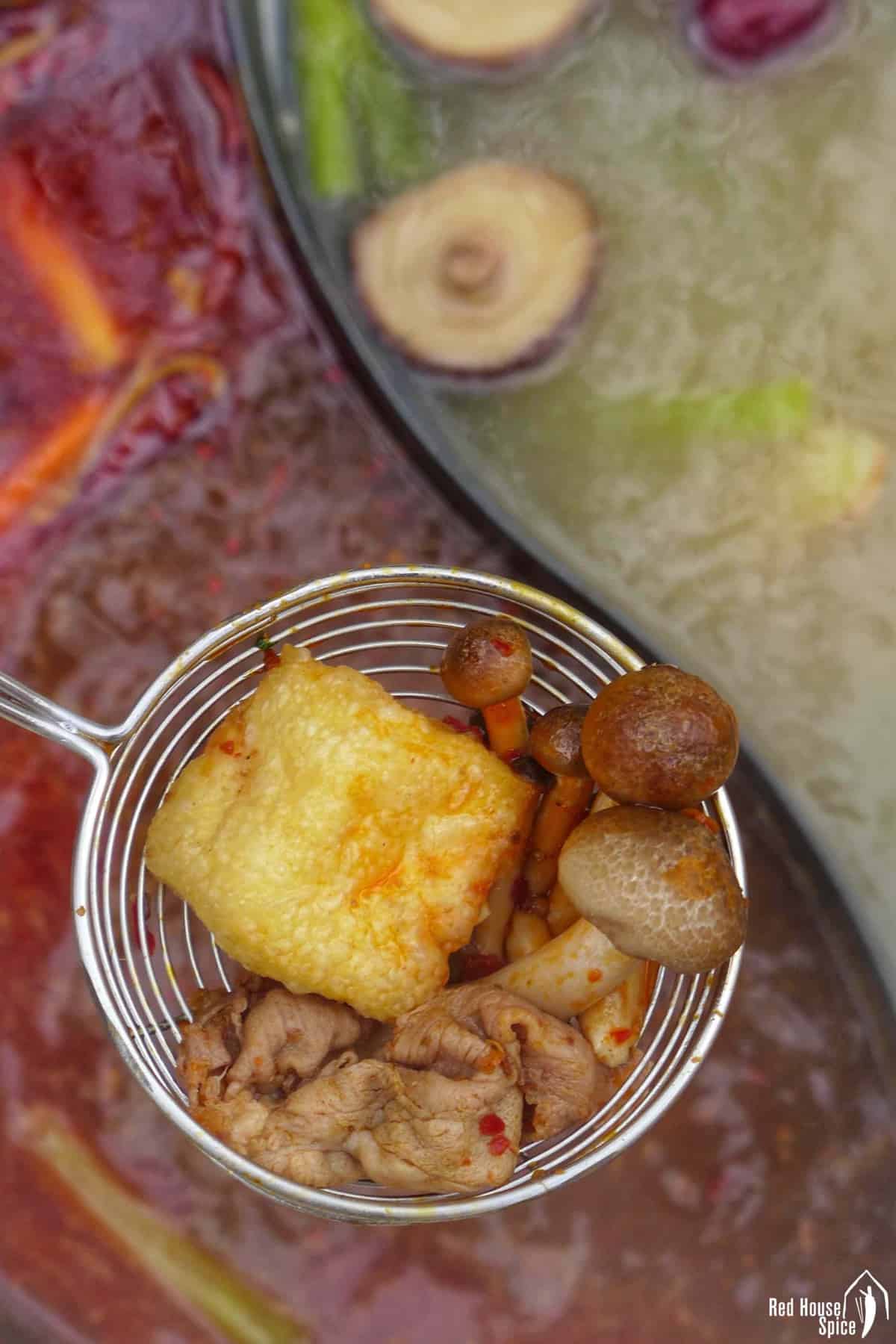
- Wash and cut all the food items. Place them on plates. You may arrange different ingredients on the same plate but make sure you don’t mix meat, fish and seafood with others.
- Have the dipping sauces mixed and distributed in individual bowls. Keep some extra in case someone needs an adjustment or top-up, e.g. scallions, coriander, fresh chili, chili oil, salt, etc.
- Place the heat source and the pot in the middle of the table. Pour in the broth. Make sure any cable is neatly placed to avoid tripping over.
- Place plates of food items around the pot, and dipping sauce bowls, chopsticks, napkins and drinks for every diner.
- Turn on the heat. Once the broth comes to a boil, you may starting putting food items into the pot. The water in the broth evaporates as you eat. So make sure you have extra hot water ready for topping up when needed.
Pro tips
Wait for the broth to boil
It requires a little patience to enjoy hot pot. Add dipping items only when the broth starts boiling. Do not put too much food at a time as it reduces the temperature of the broth dramatically thus it’ll take longer to cook through the food. Ideally, the broth should remain simmering throughout the meal. Reduce the heat slightly if it’s boiling violently.
Cook flavourful food first
Although there aren’t set rules on what to eat first, it’s usually recommended to cook umami-rich food first, such as meat, seaweed, mushroom, etc. as they make the broth more flavorful.
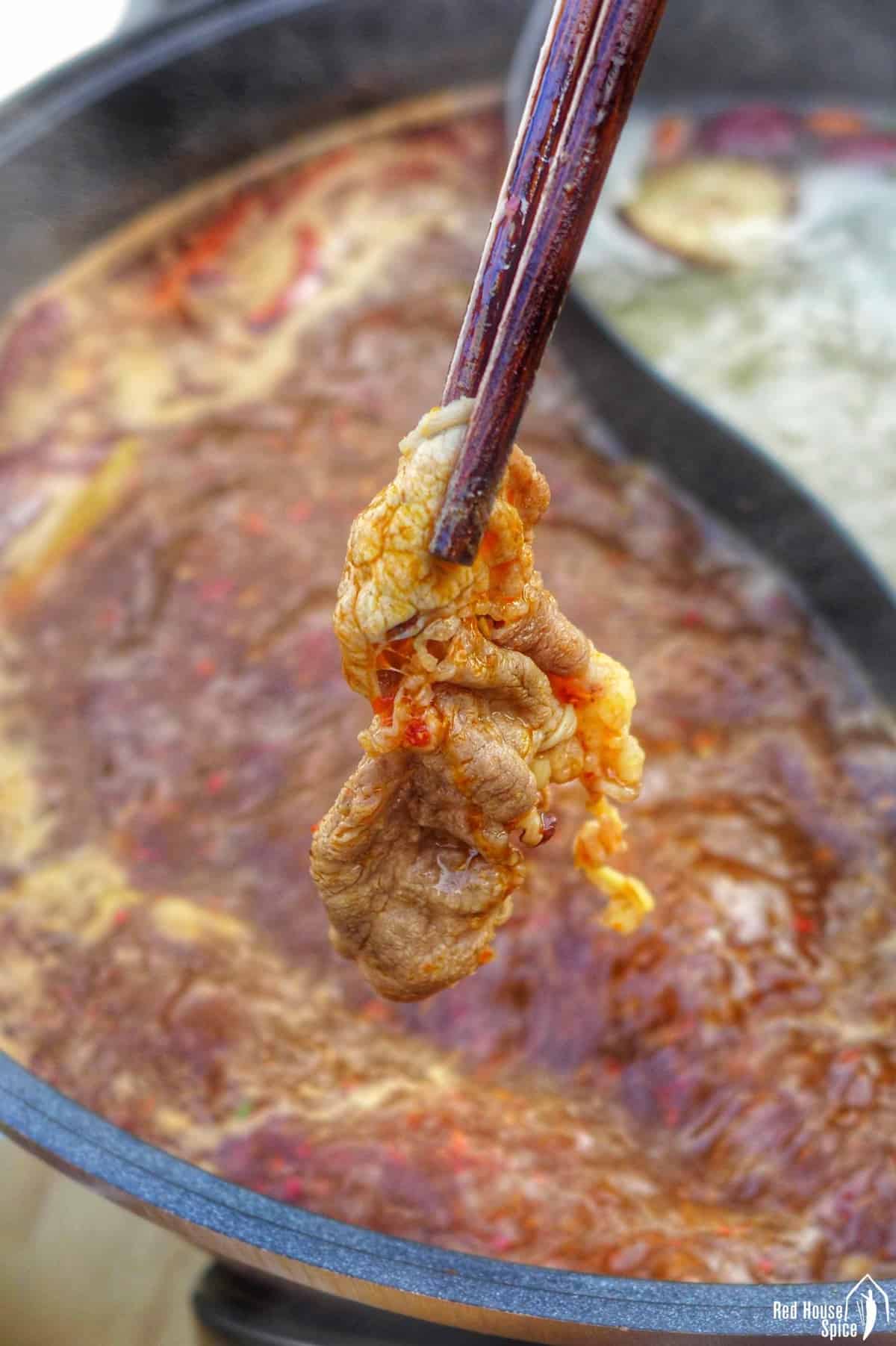
Don’t overcook certain ingredients
For optimal tenderness, it’s crucial to cook meat, fish, seafood, etc. for a short period. If you leave them in the broth for too long, they’ll become tough and chewy. Usually, they’re ready as soon as their colour changes.
Cook starchy items at the end
Foods high in starch tend to thicken the broth so it’s best to cook them at the end of the meal. Also, do not leave them in the broth longer than necessary. This rule applies to potatoes, sweet potatoes, all types of noodles and dumplings.
Stay hygienic
When eating hot pot, chopsticks have two missions: picking up raw ingredients to add to the broth and fishing out cooked food to eat. So diners must follow a hygienic procedure: keep the tips of the chopsticks in the boiling broth for a few seconds right after handling raw food (particularly meat, fish and seafood).
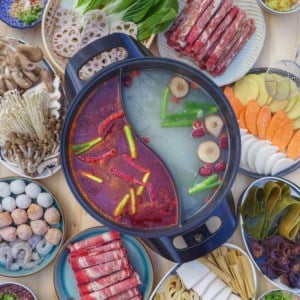
Chinese Hot Pot At Home
BEFORE YOU START
EQUIPMENT
- A tabletop heat source
- A wide and shallow pot or wok that sits stably over the heat source. It can be a divided pot that holds two separate broth.
Ingredients
Hot pot broth (choose one or use both in a divided pot)
- Spicy hot pot broth - homemade or shop-bought
- Mild hot pot broth - homemade or shop-bought
Meat options
- Beef, lamb or pork, cut into thin slices against the grain. - choose well-marbled cuts if possible
- Precooked meatballs - defrosted if frozen
- Canned meat (Spam), sliced
Fish & seafood options
- Boneless fish fillet, thinly sliced - e.g. halibut, catfish, cod, sea bass, pangasius, etc.
- Shrimp, with or without the skin/head
- Squid, sliced
- Fish balls
- Fish or shrimp paste - shaped into balls while having the hot pot
- Other seafood - such as crabs, clams, mussels, etc.
Soybean-based ingredient options
- Tofu (silken, soft or firm), sliced
- Frozen tofu, defrosted and sliced
- Tofu puffs (deep-fried tofu)
- Pressed tofu sheets, cut into wide strips
- Dried tofu skin, rehydrated beforehand
Mushroom options
- Oyster mushrooms, separated into small sections
- King oyster mushrooms, sliced lengthways
- Enoki mushrooms, ends removed and torn into small bundles
- Shiitake mushrooms - rehydrated if in dried form
- Shimeji mushrooms, ends removed
Leafy green options
- Napa cabbage
- Bok Choy
- Choy Sum
- Gai Lan
- Crown daisy (Tong Hao)
- Water spinach
- Watercress
Root vegetable options
- Potato, peeled and sliced
- Sweet potato, peeled and sliced
- Daikon (white radish), sliced
- Lotus roots, sliced
Dried ingredient options
- Kelp, rehydrated and cut into strips
- Wood ear, rehydrated beforehand
Noodle options
- Fresh wheat noodles - e.g. ramen, homemade or instant
- Fresh rice noodles
- Sliced rice cakes
- Mung bean vermicelli, pre-soaked
- Sweet potato glass noodles, pre-soaked
- Hand-pulled noodles - have the dough made, rested and cut into strips. Pull one noodle at a time and drop it into the broth straightaway.
Dumpling options
Dipping sauce ingredients (mix and match based on your preference)
- Sauces: light soy sauce, black rice vinegar, oyster sauce, shacha sauce (Chinese barbecue sauce)
- Pastes: sesame paste, peanut butter, fermented bean curd
- Oil: sesame oil, chilli oil
- Spices: chili powder, ground Sichuan pepper
- Aromatics: minced garlic, coriander, scallions, fresh chilli
- Nuts: sesame seeds, toasted peanuts
Instructions
- Place the heat source and the pot/wok in the middle of the table. Pour in the broth. Place various food items around the pot (See note 1).
- Have the dipping sauces mixed and distributed in individual bowls. Keep some extra in case you need an adjustment or top-up during the meal.
- Turn on the heat. Once the broth comes to a boil, you may start putting food items into the broth to cook (See note 2). Fish out the cooked items and enjoy with the dipping sauce.
- The water in the broth evaporates as you eat. Top up with hot water when needed.
NOTES
NUTRITION DISCLOSURE: Nutritional information on this website is provided as a courtesy to readers. It should be considered estimates. Please use your own brand nutritional values or your preferred nutrition calculator to double check against our estimates.


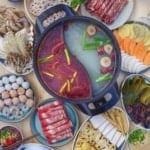

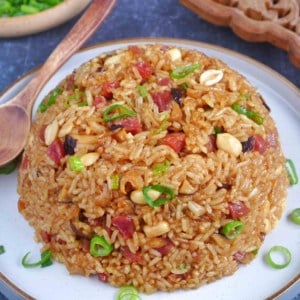
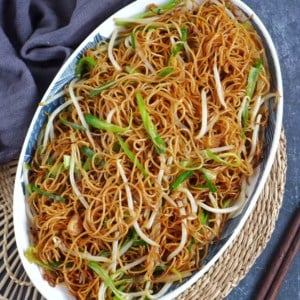
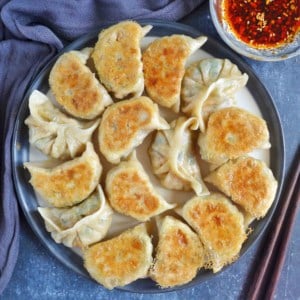
Thanks it was superb when I made it yummy 😊
So happy to hear that!
This is very detailed, thanks for this.
My pleasure to share!
Very excited to try this with our divided hot pot for CNY 2022. Going to practice making the broths from scratch. We lived in HK for many years and really miss having hot pot with friends. Thank you for this guide!
You’re welcome Mary! Hot pot makes a wonderful meal for Chinese New Year. Enjoy!